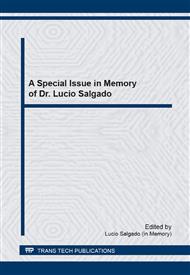p.519
p.525
p.530
p.536
p.541
p.547
p.553
p.558
p.564
Characterization of a Quartzite Residue and its Application in Red Clay Ceramics
Abstract:
The fabrication of conventional red clay ceramics products for civil construction, such as bricks and roofing tiles, normally uses other raw materials like sand, in addition to clay, as a way to condition the final ceramic properties. Quartzite residues, from ornamental stone processing in the northeast region of Brazil, could be used as possible conditioner material for clay body in a ceramic industry owing to its similar characteristics to common sand. In the present work, complementing a recent publication on the same materials, a quartzite residue was characterized and its potential as a red clay ceramic addition was evaluated for different composition up to 40 wt%. The results indicated economical advantages in association with some technical benefits.
Info:
Periodical:
Pages:
541-546
Citation:
Online since:
September 2014
Price:
Сopyright:
© 2015 Trans Tech Publications Ltd. All Rights Reserved
Share:
Citation:


